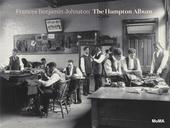
|
Frances Benjamin Johnston: The Hampton Album
Hardback
Main Details
| Title |
Frances Benjamin Johnston: The Hampton Album
|
| Authors and Contributors |
Edited by Sarah Hermanson Meister
|
|
Contributions by LaToya Ruby Frazier
|
| Physical Properties |
|
| Category/Genre | Photographs: collections |
|---|
| ISBN/Barcode |
9781633450813
|
| Classifications | Dewey:779.9378755412 |
|---|
| Audience | |
|---|
|
Publishing Details |
| Publisher |
Museum of Modern Art
|
| Imprint |
Museum of Modern Art
|
| Publication Date |
30 May 2019 |
| Publication Country |
United States
|
Description
Comprised of 159 extraordinary platinum plates, Frances Benjamin Johnston's Hampton Album documents life at the Hampton Institute marking a pivotal moment in this historically black university's history . Frances Benjamin Johnston (American, 1864-1952), one of the first women in America to work as a professional photographer, was commissioned in 1899 to photograph the Hampton Institute, then a thirty year old institution dedicated to the practical and academic education of freed slaves and Native Americans. What became known as the Hampton Album - comprised of 159 platinum plates exhibited in 1900 at the Exposition Universelle in Paris - is Johnston's signature work, and has become a touchstone for contemporary historians and artists. The leather-bound album was discovered serendipitously by Lincoln Kirstein in a Washington, D.C. bookstore during World War II and donated to MoMA in 1965.
Author Biography
Sarah Hermanson Meister is a Curator in the Department of Photography at The Museum of Modern Art, New York. Frances Benjamin Johnston (American, 1864-1952) achieved acclaim as a photo journalist and studio photographer based in Washington, D.C., and is recognized as a pioneer for women in photography. LaToya Ruby Frazier is currently an Associate Professor of Photography at the School of the Art Institute of Chicago and is represented by Gavin Brown's Enterprise in New York.
ReviewsJohnston's photographs show students attending lectures or practicing manual skills, and they are so deliberately posed and choreographically distributed that they appear suspended in space; the scenes resemble theater photos of the fin de siecle, or early film stills.--Luc Sante "New York Times: Book Review"
|